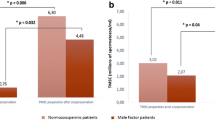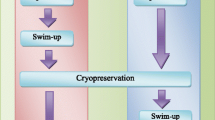Abstract
Purpose
Cryopreservation of sperm is a widely used technique to maintain and protect the fertility in various occasions such as infertility and malignancy treatments. This study aims to reveal the effects of freezing and thawing on human spermatozoa.
Materials and methods
To evaluate the effects of freeze–thawing, semen samples were evaluated by light microscopy by means of morphology, motility and viability, by scanning and transmission electron microscopy for detailed ultrastructural changes.
Results
After cryopreservation, a significant decrease in spermatozoa viability was observed (p < 0.01). Group a, b and c motility according to World Health Organization criteria decreased considerably (p < 0.05, p < 0.01, p < 0.05, respectively), whereas there was a substantial increase in group d motility. A strong correlation between rise in number of immotile spermatozoa and decrease in viability was also noted (r = −0.848, p < 0.01). Post-thaw light microscopic studies revealed a considerable decrease in rate of normal spermatozoa (p < 0.05). A considerable decline in the rate of normal sperm was also observed by TEM (p < 0.05). Statistically, acrosomal changes and subacrosomal swelling were found to be significantly increased (both p < 0.05), where the latter appears to be a novel finding in literature.
Conclusion
Cryopreservation has deleterious effects on spermatozoa, especially on plasmalemma, acrosomes and tails. Electron microscopy is the ultimate modality to investigate spermatogenic cells.









Similar content being viewed by others
References
Kelleher S, Wishart SM, Liu PY, Turner L, Di Pierro I, Conway AJ, et al. Long-term outcomes of elective human sperm cryostorage. Hum Reprod 2001;16:2632–9. doi:10.1093/humrep/16.12.2632.
Keros V, Rosenlund B, Hultenby K, Aghajanova L, Levkov L, Hovatta O. Optimizing cryopreservation of human testicular tissue: comparison of protocols with glycerol, propanediol and dimethylsulphoxide as cryoprotectants. Hum Reprod 2005;20:1676–87. doi:10.1093/humrep/deh797.
Rofeim O, Gilbert BR. Long-term effects of cryopreservation on human spermatozoa. Fertil Steril 2005;84:536–7. doi:10.1016/j.fertnstert.2005.02.035.
Desrosiers P, Legare C, Leclerc P, Sullivan R. Membranous and structural damage that occur during cryopreservation of human sperm may be time-related events. Fertil Steril 2006;85:1744–52. doi:10.1016/j.fertnstert.2005.11.046.
Medeiros CMO, Forell F, Oliveira ATD, Rodrigues JL. Current status of sperm cryopreservation: Why isn’t it better? Theriogenology 2002;57:327–44. doi:10.1016/S0093-691X(01)00674-4.
Oehninger S, Duru NK, Srisombut C, Morshedi M. Assessment of sperm cryodamage and strategies to improve outcome. Mol Cell Endocrinol 2000;169:3–10. doi:10.1016/S0303-7207(00)00343-9.
Revel A, Haimov-Kochman R, Porat A, Lewin A, Simon A, Laufer N, et al. In vitro fertilization–intracytoplasmic sperm injection success rates with cryopreserved sperm from patients with malignant disease. Fertil Steril 2005;84:118–22. doi:10.1016/j.fertnstert.2005.01.121.
Saito K, Suzuki K, Iwasaki A, Yumura Y, Kubota Y. Sperm cryopreservation before cancer chemotherapy helps in the emotional battle against cancer. Cancer 2005;104:521–4. doi:10.1002/cncr.21185.
Orwig KE, Schlatt S. Cryopreservation and transplantation of spermatogonia and testicular tissue for preservation of male fertility. J Natl Cancer Inst Monogr 2005;34:51–6. doi:10.1093/jncimonographs/lgi029.
Shin D, Lo KC, Lipshultz LI. Treatment options for the infertile male with cancer. J Natl Cancer Inst Monogr 2005;34:48–50. doi:10.1093/jncimonographs/lgi004.
Nagashima T, Muroi K, Kawano-Yamamoto C, Miyoshi T, Ohmine K, Toshima M, et al. Autologous gamete cryopreservation before hemopoietic stem cell transplantation. Med Sci Monit 2005;11:CR91–4.
Wallace WH, Anderson RA, Irvine DS. Fertility preservation for young patients with cancer: who is at risk and what can be offered? Lancet Oncol 2005;6:209–18. doi:10.1016/S1470-2045(05)70092-9.
Nallella KP, Sharma RK, Said TM, Agarwal A. Inter-sample variability in post-thaw human spermatozoa. Cryobiology 2004;49:195–9. doi:10.1016/j.cryobiol.2004.07.003.
Zamboni L. The ultrastructural pathology of the spermatozoon as a cause of infertility: the role of electron microscopy in the evaluation of semen quality. Fertil Steril 1987;48:711–34.
Menkveld R, Oettle EE, Kruger TF, Swanson RJ, Acosta AA, Oehninger S. Atlas of human sperm morphology. Baltimore, MD: Williams & Wilkins; 1991.
World Health Organization. Laboratory manual for the examination of human semen and sperm-cervical mucus interaction. 4th ed. New York: Cambridge University Press; 1999.
Bjorndahl L, Söderlund I, Kvist U. Evaluation of the one-step Eosin–Nigrosin staining technique for human sperm vitality assessment. Hum Reprod 2003;4:813–6. doi:10.1093/humrep/deg199.
Hammadeh EM, Georg T, Rosenbaum P, Schmidt W. Association between freezing agent and acrosomal damage of human spermatozoa from subnormal and normal semen. Andrologia 2001;33:331–6. doi:10.1046/j.1439-0272.2001.00462.x.
Donnelly ET, Steele EK, McClure N, Lewis SEM. Assessment of DNA integrity and morphology of ejaculated spermatozoa from fertile men before and after cryopreservation. Hum Reprod 2001;16:1191–9. doi:10.1093/humrep/16.6.1191.
Meseguer M, Molina N, Garcia-Velasco JA, Remohi J, Pellicer A, Garrido N. Sperm cryopreservation in oncological patients: a 14-year follow-up study. Fertil Steril 2006;85:640–5. doi:10.1016/j.fertnstert.2005.08.022.
Hammadeh ME, Askari AS, Georg T, Rosenbaum P, Schmidt W. Effect of freeze–thawing procedure on chromatin stability, morphological and membrane integrity of human spermatozoa in fertile and subfirtile men. Int J Androl 1999;22:155–62. doi:10.1046/j.1365-2605.1999.00162.x.
Morris GJ. Rapidly cooled human sperm: no evidence of intracellular ice formation. Hum Reprod 2006;21:2075–83. doi:10.1093/humrep/del116.
Buhr MM, Fiser P, Bailey JL, Curtis EF. Cryopreservation in different concentrations of glycerol alters boar sperm and their membranes. J Androl 2001;22:961–9.
Gilmore JA, Liu J, Gao DY, Critser JK. Determination of optimal cryoprotectants and procedures for their addition and removal from human spermatozoa. Hum Reprod 1997;12:112–8. doi:10.1093/humrep/12.1.112.
Escalier D, Bisson JP. Quantitative ultrastructural modifications in human spermatozoa after freezing. In: David G, Price WS, editors. Human artificial insemination and semen preservation. New York: Plemum; 1980. p. 107–122.
Alamaneni SS, Agarwal A, Rama S, Ranganathan P, Sharma RK. Comparative study on density gradients and swim-up preparation techniques utilizing neat and cryopreserved spermatozoa. Asian J Androl 2005;7:86–92.
Donnelly ET, McClure N, Lewis SE. Cryopreservation of human semen and prepared sperm: Effects on motility parameters and DNA integrity. Fertil Steril 2001;76:892–900. doi:10.1016/S0015-0282(01)02834-5.
Szczygiel MA, Kusakabe H, Yanagimachi R, Whittingham DG. Seperation of motile populations of spermatozoa prior to freezing is beneficial for subsequent fertilization in vitro: a study with various mouse strains. Biol Reprod 2002;67:287–92. doi:10.1095/biolreprod67.1.287.
Saritha KR, Bongso A. Comparative evaluation of fresh and washed human sperm cryopreserved in vapour and liquid phases of liquid nitrogen. J Androl 2001;22:857–62.
Sanocka D, Miesel R, Jedrzejczak P, Chelmonska-Soyta AC, Kurpisz M. Effect of reactive oxygen species and the activity of antioxidant systems on human semen; association with male infertility. Int J Androl 1997;20:255–64. doi:10.1046/j.1365-2605.1997.00050.x.
Zini A, Fischer MA, Mak V, Phang D, Jarvi K. Catalase-like and superoxide dismutase-like activities in human seminal plasma. Urol Res 2002;30:321–3. doi:10.1007/s00240-002-0283-0.
Koca Y, Ozdal OL, Celik M, Unal S, Balaban N. Antioxidant activity of seminal plasma in fertile and infertile men. Arch Androl 2003;49:355–9. doi:10.1080/713828214.
Mancini A, Meucci E, Milardi D, Giacchi E, Bianchi A, Pantano AL, et al. Seminal antioxidant capacity in pre- and postoperative varicocele. J Androl 2004;25:44–9.
Critser JK, Huse-Benda AR, Aaker DV, Arneson BW, Ball GD. Cryopreservation of human spermatozoa III. The effect of cryoprotectants on motility. Fertil Steril 1998;50:314–20.
O’Connel M, McClure N, Lewis SEM. The Effects of cryopreservation on sperm morphology, motility and mitochondrial function. Hum Reprod 2002;17:704–9. doi:10.1093/humrep/17.3.704.
de Paula TS, Bertolla RP, Spaine DM, Cunha MA, Schor N, Cedenho AP. Effect of cryopreservation on sperm apoptotic deoxyribonucleic acid fragmentation in patients with oligozoospermia. Fertil Steril 2006;86:597–600. doi:10.1016/j.fertnstert.2006.01.047.
Hammadeh ME, Szarvasy D, Zeginiadou T, Rosenbaum P, Georg T, Schmidt W. Evaluation of cryoinjury of spermatozoa after slow (programmed biological freezer) or rapid (liquid nitrogen vapour) freeze-thawing techniques. J Assist Reprod Genet 2001;18:364–70. doi:10.1023/A:1016666221500.
Gandini L, Lombardo F, Lenzi A, Spano M, Dondero F. Cryopreservation and sperm DNA integrity. Cell Tissue Bank 2006;7:91–8. doi:10.1007/s10561-005-0275-8.
Kam TL, Jacobson JD, Patton WC, Corselli JU, Chan PJ. Retention of membrane charge attributes by cryopreserved-thawed sperm and zeta selection. J Assist Reprod Genet 2007;24:429–34. doi:10.1007/s10815-007-9158-1.
Oettle EE, Soley JT. Ultrastructural changes in the acrosome of human sperm during freezing and thawing: a pilot trial. Arch Androl 1986;17:145–50. doi:10.3109/01485018608990187.
Silva PF, Gadella BM. Detection of damage in mammalian sperm cells. Theriogenology 2006;65:958–78. doi:10.1016/j.theriogenology.2005.09.010.
Virtanen I, Bradley RA, Paasivuo R, Lehto VP. Distinct cytoskeletal domains revealed in sperm cells. J Cell Biol 1984;99:1983–91. doi:10.1083/jcb.99.3.1083.
Nawroth F, Isachenko V, Dessole S, Rahimi G, Farina M, Vargiu N, et al. Vitrification of human spermatozoa without cryoprotectants. Cryo Lett 2002;23:93–102.
Isachenko V, Isachenko E, Katkov II, Montag M, Dessole S, Nawroth F, et al. Cryoprotectant-free cryopreservation of human spermatozoa by vitrification and freezing in vapour: effect on motility, DNA integrity, and fertilization ability. Biol Reprod 2004;71:1167–73. doi:10.1095/biolreprod.104.028811.
Liu JL, Kusakabe H, Chang CC, Suzuki H, Schmidt DW, Julian M, et al. Freeze-dried sperm fertilization leads to full-term development in rabbits. Biol Reprod 2004;70:1776–81. doi:10.1095/biolreprod.103.025957.
Isachenko V, Isachenko E, Montag M, Zaeva V, Krivokharchenko I, Nawroth F, et al. Clean technique for cryoprotectant-free vitrification of human spermatozoa. Reprod Biomed Online 2005;10:350–4.
Meyers SA. Dry storage of sperm: applications in primates and domestic animals. Reprod Fertil Dev 2006;18:1–5. doi:10.1071/RD05116.
Verheyen G, Pletincx I, Van Steirteghem A. Effect of freezing method, thawing temperature and post-thaw dilution/washing on motility (CASA) and morphology characteristics of high-quality human sperm. Hum Reprod 1993;8:1678–84.
Hammadeh ME, Dehn C, Hippach M, Zeginiadou T, Stieber M, Georg T, et al. Comparison between computerized slow-stage and static liquid nitrogen vapour freezing methods with respect to the deletorious effect on chromatin and morphology of spermatozoa from fertile and subfertile men. Int J Androl 2001;24:66–72. doi:10.1046/j.1365-2605.2001.00270.x.
Brennan AP, Holden CA. Pentoxifylline-supplemented cryoprotectant improves human sperm motility after cryopreservation. Hum Reprod 1995;10:2308–12.
Nallella KP, Sharma RK, Allamaneni SS, Aziz N, Agarwal A. Cryopreservation of human spermatozoa: comparison of two cryopreservation methods and three cryoprotectants. Fertil Steril 2004;82:913–8. doi:10.1016/j.fertnstert.2004.02.126.
Herrler A, Eisner S, Bach V, Weissenborn U, Beier HM. Cryopreservation of spermatozoa in alginic acid capsules. Fertil Steril 2006;85:208–13. doi:10.1016/j.fertnstert.2005.06.049.
Acknowledgements
This study was supported by Ankara University Scientific Research Projects with the project number of 2003-08-09-166.
Author information
Authors and Affiliations
Corresponding author
Additional information
Capsule This manuscript enlightens the ultrastructural cryo-injury mechanisms of human spermatozoa with supplementary novel acrosomal pathologies, revealing correlations between different sperm parameters following cryopreservation.
Rights and permissions
About this article
Cite this article
Ozkavukcu, S., Erdemli, E., Isik, A. et al. Effects of cryopreservation on sperm parameters and ultrastructural morphology of human spermatozoa. J Assist Reprod Genet 25, 403–411 (2008). https://doi.org/10.1007/s10815-008-9232-3
Received:
Accepted:
Published:
Issue Date:
DOI: https://doi.org/10.1007/s10815-008-9232-3




